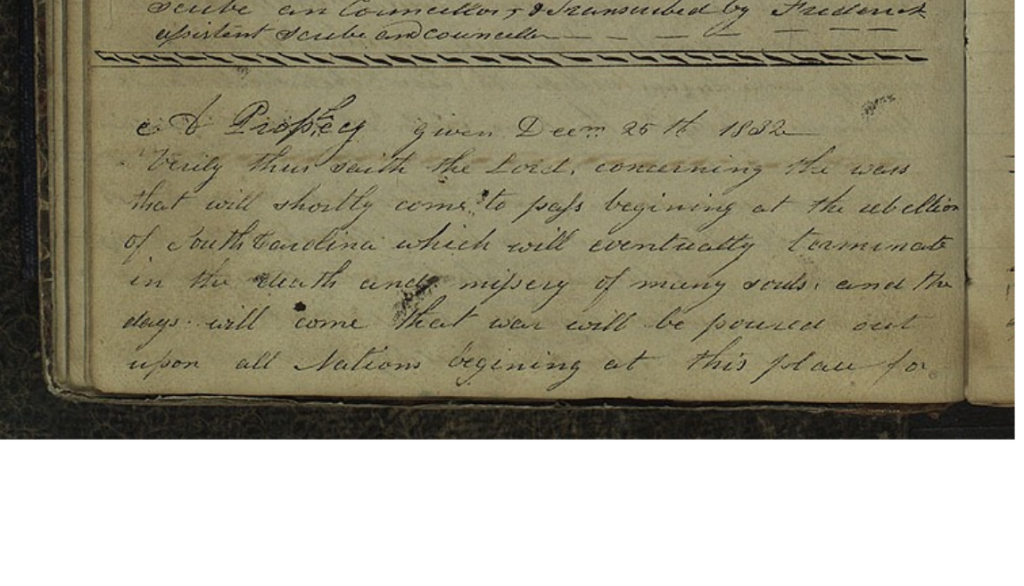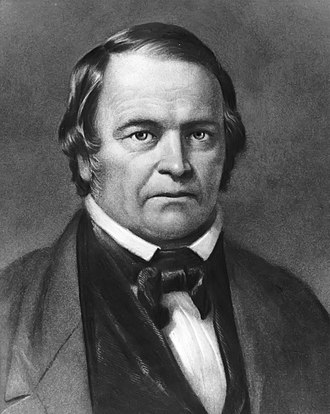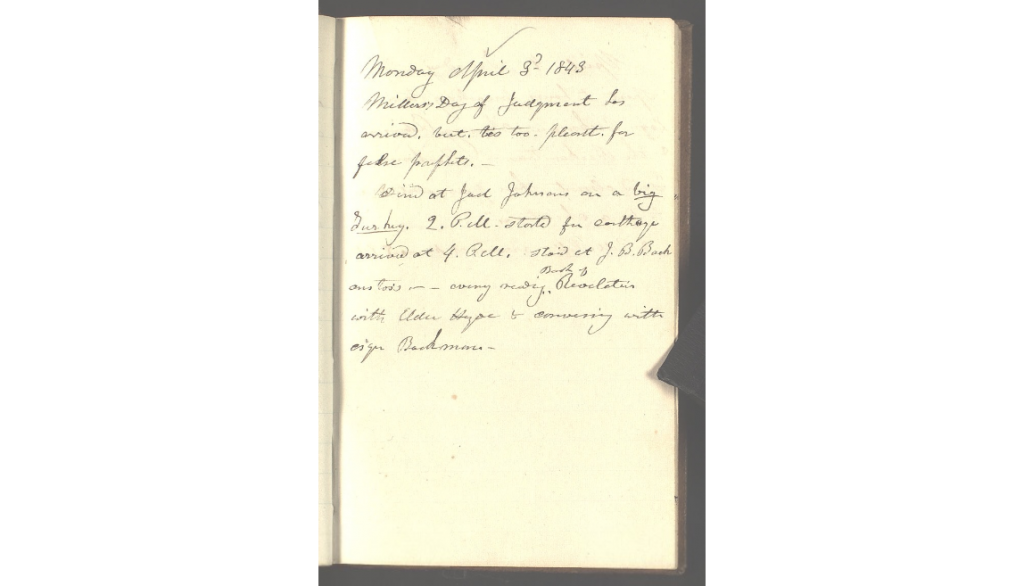Joseph Smith, Christmas, and the End of the World
Today’s post discusses what the Lord’s Christmas day 1832 revelation to Joseph Smith says about prophets, prophecy, and the end of the world. The revelation came a bit before Charles Dickens created Christmas as we know it.
The United States was in a state of political turmoil
Congress had passed tax laws that favored northern factories over southern planters. So a South Carolina convention “unilaterally nullified the tariff and forbade its collection. President Andrew Jackson, refusing to acknowledge this assertion of state power, called out troops. By Christmas 1832, a military confrontation appeared imminent” (Bushman, Rough Stone Rolling, 191).
Latter-day Saints and other Christians
Viewed these events (along with a plague in India and a nearly global outbreak of cholera) in eschatological terms. Ess-cat-a-loj-i-cal is an adjective. Es-ca-tahn is the related noun, and it means the end of the world. Es-ca-tall-o-gee is theology about the end of the world.
The eschaton must be coming soon
At least that’s how it looked to Joseph Smith and others that Christmas. The United States was on the brink of civil war. Wars and rumors of wars, desolating sicknesses and desolating scourges were in the news (“Signs of the Times,” The Evening and the Morning Star 1:8 [January 1833], 62.) Joseph asked for and received a revelation about what was to come. It said that wars–plural–would begin shortly with South Carolina’s rebellion, then continue until wars had gone global and resulted in “a full end of all nations” (D&C 87:6). The revelation foresaw slave rebellions and the uprising of “remnants” vexing the Gentiles, which Joseph and the early Saints would have interpreted in Book of Mormon terms to mean descendants of Lehi irritating the unrepentant (Mormon 7:1-10, 3 Nephi 10, D&C 19:27).
This revelation is mainly descriptive, not prescriptive
D&C 87:1-7 describes what God knows will happen because people reject His laws and His love. It’s not about what He wants to happen, or what would happen if people obeyed His laws and reflected His love. It describes unfathomable violence by which the inhabitants of the earth “feel the wrath, and indignation, and chastening hand of an Almighty God” whom they have rejected. Given the impending eschaton, the prescriptive point in the last verse is “stand ye in holy places, and be not moved” (D&C 87:8).

Is that a command to be passive?
Does it mean we should be a bystander or immobilized by fear? I don’t think so. I think it means something like, take a stand for holiness and don’t get pushed around. I interpret it as a command to take an immovable stand for the laws and love of God in a world descending into self-destruction. The otherwise depressing revelation ends with good news for those who take such a stand: The day of the Lord–the eschaton–comes quickly (D&C 87:8).
Joseph Smith may have looked foolish to some when the crisis blew over
Civil war didn’t come. It didn’t start with the rebellion of South Carolina, nor result in death and misery, or global warfare, or the end of nations. Well, at least not right away, as Joseph and others probably expected.
The eschaton never seems to happen as expected
When I was a kid in the 70s and a teenager in climactic years of the Cold War, I didn’t know the words eschaton or eschatology. I didn’t read the scriptures much nor understand what I read. I just knew—I was certain—that the Second Coming of Jesus Christ was inseparably connected with MAD, the mutually assured destruction we all anticipated when the US and the Soviet Union inevitably started raining nuclear bombs on each other. What I saw was all there was. I had no sense of history, the long history of war and violence or of Christian eschatology. I had no idea that what I assumed was different from what I knew. I thought I knew all there was to know about the topic. It was black and white.
Then the world didn’t end when or how I expected it to
That’s the story of Christian eschatology in a nutshell. Since the days of Paul at least, Christians have been expecting the end of the world any day. Every generation of Christians has waited for the end times, and there are always some Christians somewhere who are sure that it’s coming very, very soon.
Early Latter-day Saints were like that

But not quite as much as the followers of William Miller. He was a generation older than Joseph Smith. He was a Baptist, then a Deist, but the combination of having his life miraculously saved in the War of 1812 and the deaths of loved ones led him to conversion to Jesus Christ, and he renewed his Baptist faith. He longed for Jesus’ return to end wars and death. Like me, William Miller didn’t have the knowledge or skills or the revelation necessary to read and understand apocalyptic parts of the Bible in context. So he made some assumptions that led him to interpret Daniel 8:14 to mean that the Savior would return sometime between March 21, 1843 and a year later.
Some of William Miller’s followers got even more specific
They narrowed the day of the Savior’s Second Coming to April 3, 1843. They were not the only ones interested as that day approached. Latter-day Saints were also looking forward to the Savior’s Second Coming, studying the prophecies, trying to discern the signs of the times, as Christians had been doing for nearly two millennia.
So It was no wonder that on Sunday April 2, 1843
the subject came up in Elder Orson Hyde’s sermon. Joseph’s journal entry for that day says “Elder Hyde Preached 1 epistle John 1 chap 1st 3 verses–when he shall appear we shall be like him &c he will appear on a white horse–as a warrior & may be we shall have some of the same spirit–our god is a warrior–John 14:23–it is our privilege to have the father & son dwelling in our hearts &c . . . . .” After the sermon Joseph had lunch with Elder Hyde, and said, “Elder Hyde I am going to offer some corrections to you. Elder H. replid–they shall be thankfully received.”
Joseph clarified that when the Savior appears
“we shall see him as he is. We shall see that he is a man like ourselves. And that same sociality which exists amongst us here will exist among us there only it will be coupled with eternal glory which glory we do not now enjoy.”Joseph taught further that John 14:23 is about “a personal appearance” of the Father and the Son. “To say that the father and the Son dwells in a man’s heart is an old Sectarian notion. and is not correct. . . . ”
Then Joseph prophesied
“I prophecy in the Name of the Lord God that the commenceme[n]t of bloodshed as preparat[o]ry to the coming of the son of man. will commenc[e] in South Carolina.— (it probably may arise through the slave trade.)— this the a voice declard to me. while I was praying earne[s]tly on the subje[c]t 25 December 1832. I earnestly desird to know concern[in]g the coming of the Son of Man & prayed. when— a voice said to me, Joseph, my, son, if thou livest until thou art 85 years old thou shalt see the facce of the son of man. therefore let this suffice & trouble me no more on this matter.”
The next day was April 3, 1843

It turned out not to be the eschaton. Joseph’s journal entry pokes at Miller and his followers: “tis too. pleas[a]nt. for false prophets.” A few days later on April 6, 1843, Joseph again told his experience a decade earlyer of praying to know when the Savior’s Second Coming would be, and this time he added how he had decided to interpret the Lord’s intentionally vague revelation:
“. . . were I going to prophecy. I would procpesy [prophesy] the end will not come in 1844. or 5— or 6. or 40 years more [p. [72]] there are those of the rising generation who shall not taste death till christ come. <I was once praying earnestly upon this subject. and a voice said unto me.> My son, if thou livest till thou art 85 years of age, thou shalt see the face of the son of man. . . . <I was left to draw my own conclusions concerni[n]g this &,> I took the liberty to conclude that if I did live till that time Jesus <he> would make his appearance.— <but I do not say whether he will make his appeara[n]ce, or I shall go where he is.—> I prophecy in the name of the Lord God.— & let it be written. <that the> Son of Man will not come in the heavns till I am 85. years old 48 years hence or about 1890.—” (cross ref. D&C 130:14-17).
I’m quite fascinated by the way
Joseph read his own revelations in the context of his culture’s eschatology. He accurately prophesied the American Civil War, but he didn’t understand his own prophecy. When he received the Christmas revelation in 1832, as South Carolina was threatening secession, he assumed, as almost all Christians have done, that the Savior’s Second Coming would be soon. Then in 1843 Joseph specifically noted the difference between what the Lord revealed and what he, Joseph, interpreted it to mean:
The Lord’s revelation:
“Joseph, my, son, if thou livest until thou art 85 years old thou shalt see the face of the son of man. therefore let this suffice & trouble me no more on this matter.”
Joseph’s interpretation:
“I was left to draw my own conclusions concerni[n]g this &,> I took the liberty to conclude that if I did live till that time Jesus <he> would make his appearance.— <but I do not say whether he will make his appeara[n]ce, or I shall go where he is.—> I prophecy in the name of the Lord God.— & let it be written. <that the> Son of Man will not come in the heavns till I am 85. years old 48 years hence or about 1890.—”
This is a terrific way to show that Joseph Smith was a true prophet of God and a frontier farmer in the antebellum (pre Civil War) United States. That means that he knew things from God that no one else could, and that he understood them as most everyone else in his time and place would.
One reason that Joseph was such a good revelator is that he worked at what he called “the spirit of revelation.” He taught:
“A person may profit by noticing the first intimation of the Spirit of Revelation for instance when you feel pure Inteligence flowing unto you it may give you sudden strokes of ideas that by noticeting it you may find it fulfilled the same day or soon. (I,E,) those things that were presented unto your minds by the Spirit of God will come to pass and thus by learning the Spirit of God. & understanding it you may grow into the principle of Revelation. until you become perfect in Christ Jesus.”
Sometimes Joseph didn’t understand
How to interpret the Lord’s revelations, at least not right away. He had to work at it and see how things unfolded first. He referred to his Christmas 1832 revelation occasionally but never published it during his lifetime. Latter-day Saints began to pay attention to it in the 1850s as the American Civil War loomed. Then, in 1861, when it began to be fulfilled to the letter, a Philadelphia newspaper reprinted the revelation and asked, “Have we not had a prophet among us?” (“A Mormon Prophecy,” Philadelphia Sunday Mercury, 5 May 1861, reprinted in Robert J. Woodford, The historical development of the Doctrine and Covenants, 3 volumes [PhD dissertation, Brigham Young University, 1974], 2:1110).
Joseph didn’t always get it right
There was a gap between what God revealed through him and his limited ability to understand, interpret, and explain. He wasn’t a perfect revelator. He was just the best one the world has ever seen. Happy birthday Brother Joseph. And Merry Christmas everyone. Be of good cheer! When the news is bleak and violence leads to death and misery across the globe, take a stand for holiness and don’t move.

Thank you, Brother Harper, for helping us better understand Joseph’s understanding of this Christmas Day revelation. I loved when you said he wasn’t a perfect revelator, just the best we’ve ever had! Thank you for helping me to allow him his imperfections while absolutely acknowledging the veracity that he is a Prophet!